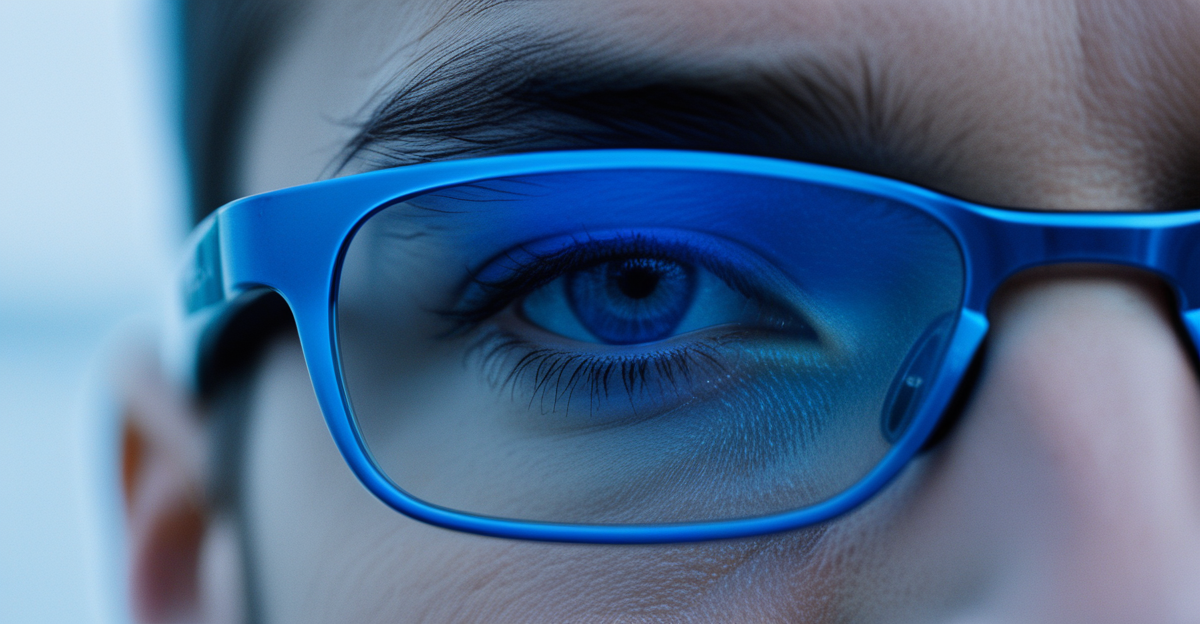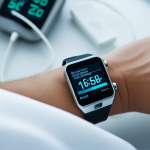Understanding Blue Light and Digital Eye Strain
Exploring the effects of screen time on eye health
Blue light exposure comes primarily from digital screens like smartphones, computers, and tablets. This high-energy visible light penetrates the eye, potentially causing discomfort when exposure is excessive. Digital devices emit significant amounts of blue light, especially during prolonged use, making this exposure a common concern in today’s tech-driven lifestyles.
Also to see : Unlocking the power of light: a comprehensive guide to overcoming seasonal affective disorder
Digital eye strain results from extended screen time impacts, manifesting as symptoms such as dryness, irritation, blurred vision, and headaches. It occurs because the eyes continuously adjust to focus and process intense blue light. Unlike general vision fatigue caused by factors like poor lighting or uncorrected refractive errors, digital eye strain specifically relates to the interactive nature and brightness of screens emitting blue light.
Understanding these differences is vital to addressing discomfort. Unlike typical tiredness, digital eye strain often worsens with sustained screen use and lacks relief from resting the eyes alone. Managing the effects requires targeted strategies focused on minimizing blue light exposure and optimizing screen habits, directly addressing the unique challenges posed by modern digital environments.
In parallel : Experience pain relief with a chiropractor in west malling
Understanding Blue Light and Digital Eye Strain
Blue light exposure primarily comes from everyday digital devices such as smartphones, computer screens, and LED lighting. This high-energy visible (HEV) light has shorter wavelengths and is more intense than other visible light types. Prolonged screen time impacts the eyes by increasing the risk of digital eye strain, a condition marked by symptoms like dryness, irritation, blurred vision, and headaches.
Digital eye strain differs from general vision fatigue because it specifically arises from extended exposure to digital screens rather than physical or environmental factors. The impacts of blue light exposure during long screen sessions can exacerbate these symptoms, making it harder for eyes to focus and recover. Research indicates that the flicker rate and glare from screens contribute alongside blue light, intensifying discomfort.
Understanding this connection is essential for mitigating discomfort. While digital eye strain is temporary and reversible with breaks and proper habits, unaddressed chronic exposure may lead to persistent eye issues. Reducing blue light exposure through device settings or eyewear can alleviate strain. Recognising the precise symptoms linked to screen use helps differentiate digital eye strain from other eye health concerns, enabling targeted and effective interventions.
What Are Blue Light Glasses?
Blue light glasses use eyewear technology designed to filter or block a portion of blue light exposure emitted from digital screens. This technology employs special coatings or tinting on the lenses that absorb or reflect high-energy visible (HEV) blue wavelengths, aiming to reduce the amount reaching the eyes during prolonged screen time.
These glasses come in various types and designs, ranging from clear lenses with subtle blue light filters to darker tints similar to sunglasses. Some models incorporate anti-reflective coatings to further minimize glare and screen reflections—both factors that can exacerbate digital eye strain.
The primary goal of blue light glasses is to provide screen protection by reducing eye fatigue symptoms like dryness, irritation, and blurred vision that stem from intense blue light exposure. By lessening the visual stress caused during extended device use, they help maintain comfort and focus. Users often report that wearing blue light glasses improves their ability to work on computers or smartphones without as much discomfort, suggesting these glasses function as a practical barrier against continual blue light exposure.
Understanding how blue light glasses interact with screen light helps users select the appropriate type for their needs and maximize the benefits while managing screen time impacts effectively.
What Are Blue Light Glasses?
Shedding light on eyewear technology and screen protection
Blue light glasses use specialized eyewear technology designed to filter a portion of the high-energy visible blue light emitted by digital screens. These glasses typically feature lenses coated with filters that absorb or block specific wavelengths of blue light, aiming to reduce exposure during extended screen use.
There are various types and designs of blue light glasses available, from clear lenses suitable for everyday wear to tinted lenses that offer a stronger blue light filtration effect. Some models include anti-reflective coatings to minimize glare, adding to visual comfort during long sessions in front of devices.
How do blue light glasses work? They function by reducing the amount of blue light that reaches the eyes, which can help decrease digital eye strain symptoms related to screen time impacts such as dryness, irritation, or headache. By lessening blue light exposure, these glasses target the core element responsible for eye discomfort during prolonged screen use.
While not a cure-all, blue light glasses support healthier screen habits. Choosing the right pair depends on factors like lens quality, filtration efficiency, and comfort, ensuring the technology aligns well with personal needs during screen interaction.
Scientific Evidence on Effectiveness
Exploring what research says about blue light glasses
Scientific studies evaluating the effectiveness of blue light glasses often focus on whether these glasses reduce digital eye strain and improve comfort during extended screen time. Clinical research measures parameters such as eye fatigue, dryness, blurred vision, and headaches—common symptoms linked to prolonged blue light exposure.
Several studies report that blue light glasses can reduce perceived eye strain and discomfort, particularly during long sessions of computer use. For example, participants wearing blue light glasses often experience fewer reports of visual fatigue and headaches compared to control groups without protection. However, results vary, and some trials find minimal or no statistically significant difference, highlighting ongoing debate.
Effectiveness depends on factors like lens quality, the percentage of blue light filtered, and individual sensitivity to blue light exposure. Current research emphasizes the importance of combining eyewear with safe screen habits, such as regular breaks and appropriate lighting, for optimal benefit.
While the scientific consensus is not absolute, clinical research supports that blue light glasses can offer practical relief for many users, especially those experiencing symptoms from extensive screen use. Continued studies will clarify long-term benefits and best usage practices.
Understanding Blue Light and Digital Eye Strain
Blue light exposure originates mostly from everyday digital devices like smartphones, tablets, and computer screens. This type of high-energy visible light has shorter wavelengths, leading to greater energy that can penetrate the eyes during extended use. Prolonged screen time impacts contribute directly to the development of digital eye strain, a condition characterized by symptoms such as dryness, blurred vision, irritation, and headaches.
What distinguishes digital eye strain from other vision fatigue types? Unlike general tiredness caused by poor lighting or physical fatigue, digital eye strain specifically results from continual exposure to blue light and the flicker and glare emitted by screens. This ongoing visual stress forces the eyes to repeatedly adjust focus, leading to discomfort that worsens with longer screen sessions.
Understanding the unique relationship between blue light exposure and digital eye strain is critical. It highlights why simple rest may not fully relieve symptoms if screen habits and blue light exposure remain unchanged. Addressing these factors through protective measures, such as blue light filtering strategies and optimized screen usage, can significantly reduce eye discomfort linked to modern digital living.
What Are Blue Light Glasses?
A closer look at eyewear technology designed for screen protection
Blue light glasses incorporate specialized eyewear technology aimed at filtering out a portion of the blue light emitted from digital screens. This is achieved through lenses with coatings or tints that selectively absorb or block high-energy visible blue wavelengths, decreasing blue light exposure during extended screen time.
The market offers various types of blue light glasses, including clear lenses for subtle protection and tinted lenses resembling sunglasses for stronger filtration. Some models add anti-reflective coatings to reduce screen time impacts like glare, which can worsen digital eye strain. The choice of type depends on user needs, comfort, and the degree of blue light blocking required.
By lowering blue light reaching the eyes, these glasses help mitigate symptoms commonly linked to digital eye strain, such as dryness, irritation, and blurred vision. While not a medical cure, they serve as practical tools to reduce visual discomfort during prolonged use of computers, smartphones, and tablets. Understanding how blue light glasses work enables users to select effective solutions tailored to their screen habits and eye health requirements.
Understanding Blue Light and Digital Eye Strain
Breaking down the impact of prolonged screen exposure
Blue light exposure originates mainly from digital devices such as smartphones, tablets, and computers. This visible light has a short wavelength and high energy, which can penetrate the eye more deeply than other light types. Frequent or prolonged screen time impacts increase the risk of developing digital eye strain, a condition marked by symptoms like dryness, blurred vision, irritation, and headaches.
What exactly links blue light exposure to digital eye strain? The intense blue wavelengths emitted by screens force the eyes to work harder to focus, often combined with flicker and glare. This continued effort leads to visual fatigue distinctly different from general tiredness caused by factors like poor lighting or eye health problems. Digital eye strain worsens with increasing screen duration and does not always improve simply by resting the eyes.
Understanding these differences clarifies why managing blue light exposure is crucial. It also underscores the importance of moderating screen time impacts and adopting targeted strategies to protect eye health. Unlike other vision fatigue forms, digital eye strain specifically results from the stressful interaction between the eye and sustained blue light exposure, emphasizing the need for practical solutions tailored to today’s digital habits.
Understanding Blue Light and Digital Eye Strain
Blue light exposure and its effects on eye health
Blue light exposure arises mainly from screens on devices like smartphones, computers, and tablets, common in daily life. This high-energy visible light has shorter wavelengths and penetrates deep into the eyes. Prolonged exposure during extended screen time directly contributes to digital eye strain, which differs fundamentally from general vision fatigue.
So, what sets digital eye strain apart? Unlike typical tiredness caused by environmental factors, digital eye strain specifically results from continuous blue light exposure combined with screen glare and flicker. These factors force the eyes to maintain constant focus and adjustment, leading to symptoms like dryness, irritation, headaches, and blurred vision. Importantly, these symptoms intensify with longer periods of screen use and often do not fully subside with mere rest.
Understanding this distinction helps users identify digital eye strain accurately and address it effectively. Mitigating screen time impacts requires deliberate habits and protective strategies that target blue light exposure, recognizing its key role in eye discomfort during modern device use.
Understanding Blue Light and Digital Eye Strain
Examining how screen exposure affects eye health
Blue light exposure primarily comes from everyday digital devices, including smartphones, tablets, and computer screens. This high-energy visible light has shorter wavelengths, allowing it to penetrate deeply into the eyes during extended screen time impacts. The persistent nature of blue light emission leads to increased visual strain.
Digital eye strain manifests as symptoms such as dryness, blurred vision, irritation, and headaches. Unlike general vision fatigue caused by environmental or physical factors, digital eye strain stems directly from prolonged exposure to blue light and associated flicker and glare from screens. This continuous effort forces the eyes to adjust focus repeatedly, resulting in discomfort that intensifies with longer device use.
How is digital eye strain different from other vision fatigue? While typical eye tiredness may improve with rest, digital eye strain often persists without changes to screen time impacts. This distinction is crucial; it shows that resting alone may be insufficient to alleviate symptoms without reducing blue light exposure or modifying screen habits. Awareness of this specific connection encourages targeted strategies to protect eye health in our screen-dependent world.
Understanding Blue Light and Digital Eye Strain
Breaking down the effects of prolonged screen exposure
Blue light exposure primarily comes from digital devices like smartphones, tablets, and computer monitors. This high-energy visible (HEV) light has short wavelengths that penetrate deeply into the eye. Prolonged screen time impacts involve continuous exposure to this light, which plays a central role in the onset of digital eye strain.
What defines digital eye strain compared to other vision fatigue? Unlike general tiredness from poor lighting or fatigue, digital eye strain specifically results from the demands placed on eyes during extended screen use. The blue light makes the eyes work harder, combined with flicker and glare from screens, causing symptoms such as dryness, irritation, blurred vision, and headaches. This strain worsens the longer the screen time continues.
How is digital eye strain distinct? Simply resting the eyes often does not fully alleviate discomfort because the root cause — sustained blue light exposure and screen-induced visual stress — remains. Managing these symptoms requires reducing blue light exposure and altering screen habits to minimize strain. Recognizing the nuances of digital eye strain helps users adopt effective protective strategies tailored to the realities of modern device use.











